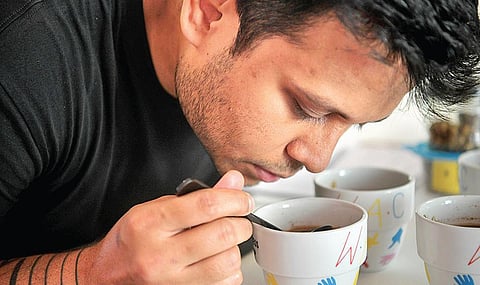

BENGALURU: Imagine having coffee breaks throughout the day! And imagine your boss insisting that you take these coffee breaks! Well, coffee tasting or cupping is not as simple as that. There is a science and a philosophy behind that hot cuppa you consume daily.
Coffee goes through a process – from beans to brew. From planting the seed to picking the fruits, to curing it, roasting it and finally grinding it – making it ready for consumption. In between the planter and the consumer, is a very important person called the taster who not only certifies that the coffee is good for consumption but also grades it, helping planters fix a price.
This profession started when consumers were able to recognise the difference in the coffees, and roasters started tasting every batch of coffee, and preparing a cupping report to ensure consistency. This report quantifies all the sensory attributes to coffee which are fragrance (dry coffee), aroma (wet coffee) and taste. Tasting evaluates coffee on flavour, body, acidity and after taste. The coffee industry took cues from the beer, wine and scotch industries as they have been doing it for much longer.
Ideally, a coffee taster should be on a bland diet for a week before tasting. However, when it becomes a regular job and tasting happens a lot more frequently, a taster shouldn’t eat for a minimum of two hours before tasting. Most of them do it first thing in the morning on an empty stomach or after a minimum of a two-hour gap.
Tasting starts with roasting and one such taster Suhas Dwarkanath (32) is a Bengaluru boy, who fell in love with coffee as a child. He used to walk past Coffee Day every day on his way to school and the aroma that wafted through made him decide that he wanted to work with coffee when he grew up. After completing MBA, he went to Dubai to pursue a job and it was then that he found out that there’s more to coffee than filter coffee. He studied at ‘Specialty Coffee Association’ and became a certified taster.
He decided to return home and opened a business called ‘Benki Brewing Tools’ making his childhood dreams a reality. The tasting room is a sacred place and is kept free of any outside smell so as to not interfere with the aroma. He says, “All your senses are working when you are tasting the coffee.” The tasting room has a red light as the human eye cannot differentiate between different shades of brown under this light making the process unbiased.
The temperature is between 22 and 26 degrees Celsius because it influences taste and anyone tasting a batch of coffee anywhere in the world should get the same result. The process is quite elaborate. A taster needs to roast the beans first as roasting is transforming the green bean to something that’s consumable and soluble in water. Tasters must have knowledge of roasting but don’t need to be roasters.
Roasting the beans caramelises the sugars, increases the size, changes colour and makes the flavours pop. The taste of the coffee depends on the soil, weather conditions and the microorganisms that migrate as these factors determine how the plant matures. For instance, if a farmer is growing pepper in the same estate, the microorganism that feeds on pepper will sit on a coffee cherry and influence the taste of the coffee.
After analysing and roasting the beans, it rests for 8-24 hours after which it is ground (coarse grind). A taster takes 8.5gm of coffee in a cup, evaluates the fragrance, then introduces 150gm of water at 92 degrees Celsius which rests for 4 minutes. The taster then breaks the crust to evaluate the aroma and slurps the coffee and evaluates the taste.
While tasting multiple cups, a taster cleanses the palate using unsweetened/unsalted crackers or just rinses mouth with plain room temperature milk. The nasal cavity is neutralised by smelling one’s skin.
Suhas also trains people and one such person is Sandesh. A computer engineer, Sandesh is married to a coffee lover. While sourcing coffee for his wife from across the globe, he decided to open a roastery. He learnt the art of tasting as every roaster needs to understand it so as to sell the right product to the right customer. He calls his business ‘Kohi Roasters’. He says, “I have found the love of my life.”
Once you fall in love with coffee you carry it everywhere you go. One such coffee taster is Ajay from Maharashtra, who, tired of being cooped during the lockdown, visited coffee estates in Chikkamagaluru and Kodagu. En route home, he stopped in Bengaluru to meet his coffee buddies and share his experiences. He has a small brewing kit and carries it wherever he goes. He says, “I can brew my coffee in a moving bus.”
COURSE CUP
To become a coffee taster, one needs to study cupping. It is available as an independent course as well as a part of other coffee courses. Specialty Coffee Association is the only one that has international recognition. It was first formed in Europe with its headquarters in Essex, UK (SCAE), and later in the USA with its headquarters in Santa Ana, California (SCAA).
WHERE THEY TEACH
Coffee Board of India
Central Coffee Research Institute, Chikkamagaluru
Benki Brewing Tools, Bengaluru
Araku, Hyderabad
POPULAR COFFEES IN INDIA